Contents
- Sweet cherry: general description of the species
- What does cherry look like
- What is cherry: varieties and varieties
- Classification of cherry varieties depending on the color of the fruit
- Systematization of sweet cherry varieties by ripening time
- Self-fertile cherries
- Pollinator varieties for self-fertile cherries
- Classification of cherry varieties depending on the height of the tree
- Separation of sweet cherry varieties according to taste characteristics
- large cherry
- Popular varieties of cherries
- Harvest cherry varieties
- Imported cherry varieties
- New varieties of cherries
- Unpretentious varieties of cherries
- What kind of cherry to choose
- Conclusion
- Reviews
Many varieties of sweet cherries have long been successfully grown by gardeners in our country. However, if earlier the traditional region of cultivation of this crop was the south, then modern zoned varieties feel good even in central Our Country and beyond the Urals. Purposeful breeding work is being carried out in this direction, which resulted in dozens of new ones.
Sweet cherry: general description of the species
Cherry is one of the oldest plants in the Plum family. It has been known for over 8000 BC. in what is now southern Europe. Its Latin name is Prunus Avium, which means “bird’s cherry”.
What does cherry look like
Cherry is a fruit tree. Its active fruiting usually begins at 4–6 years and lasts about 20 years.

cherry tree
An adult sweet cherry is a tall spreading tree with an ovoid or cone-shaped crown. In comfortable conditions, it can grow up to 15 m, usually the height is 4–5 m. It is distinguished by the rapid growth of shoots, especially at a young age. The color of the bark is brown or reddish, sometimes silvery, with clearly visible stripes. Shoots are covered with small scales.
What are the leaves of the cherry
The leaves are light green, ovate, obovate or elliptical in shape, shortly pointed with a serrated edge. Petioles up to 16 cm long. The leaf plate is wrinkled.
How cherry blossoms
This culture blooms earlier than other stone fruits. In Central Our Country, the flowering period falls on the end of April – the beginning of May. The flowers are white, five-petalled, bisexual, with numerous stamens and one pistil. The plant is self-infertile and requires pollinating neighbors to bear fruit.
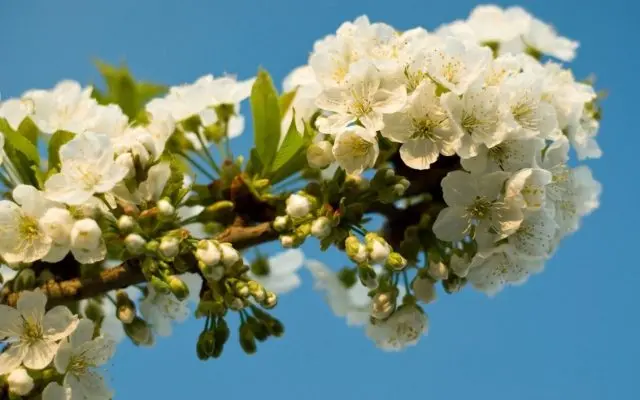
It is pollinated by bees and is a valuable honey plant.
Cherry ripening time
The timing of fruit ripening is highly dependent on the region of growth. The difference in flowering and fruiting of the same variety in different climatic conditions can be up to 1 month. The early ones in the south give a harvest already in early May, but usually the fruiting of sweet cherries begins at the end of May and ends at the latest in August.
When the cherry gives the first harvest
Most varieties of sweet cherries are fast-growing and can produce the first berries as early as 4 years after planting. Some begin to bear fruit later, for 5-6 years. The indicator of precocity is highly dependent on the growing conditions, if the place is chosen incorrectly, the plant may never bear fruit.
Cherry features
Cherry differs from its closest relative – cherry – in the presence of one powerful trunk, lighter leaves and large sizes. There are some nuances in the cultivation of this crop. Its root system is powerful, well developed. There is one tap root, but there are quite a few horizontal ones. The depth of occurrence of most of them does not exceed 0,2–0,5 m. The proximity of the roots to the surface makes any agrotechnical work in the root zone impossible, otherwise the chance of destroying the tree is very high.
This culture is more demanding on the place of growth, it does not tolerate the proximity of groundwater. For fruiting, she definitely needs a lot of sunlight and the absence of a cold wind. She will not feel good in swampy lowlands, on clay soils, or in close proximity to other trees.
The advantage of growing sweet cherries is that it begins to bear fruit before all other stone fruit crops. However, it must be borne in mind that the crop can be completely destroyed by birds that love these berries more than all other fruits. Therefore, it is imperative to take measures to protect against birds.
Where do cherries grow
The traditional regions for growing this crop are the south of Our Country: the Krasnodar Territory, the North Caucasus, and the Crimea. However, thanks to the selection work, the boundaries of cultivation were significantly expanded. Now some varieties grow well even in the Moscow region, and with proper care, it is possible to grow these fruit trees even in the Urals and Siberia.
For planting, you need to choose a sunny, well-lit place with a groundwater level of no higher than 2 m. The landing site must be protected from drafts and the north wind. The distance from neighboring trees or buildings should not be less than 3 m.
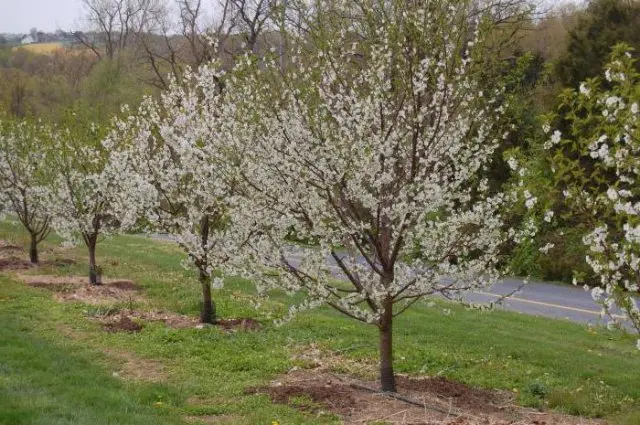
Since sweet cherries do not self-pollinate, seedlings are usually planted in a group for cross-pollination. 3 m is also left between adjacent seedlings so that the trees do not compete with each other. An important condition is that there should not be other crops between neighboring trees. For example, if you plant an apple tree between two cherries, the yield will drop by half.
Cherry grows well on light loamy soils. Heavy clay soils are not suitable for growing this crop. It will grow well on the southern slopes of gentle hills, away from tall buildings and structures.
What is cherry: varieties and varieties
Like most fruit crops, sweet cherries are classified according to the fruit ripening period. In addition, it is distinguished by the height and type of tree, the color of the berries. They also differ in resistance to diseases and frost resistance, purpose, size and taste of fruits.
Classification of cherry varieties depending on the color of the fruit
Most varieties of sweet cherries have fruits of red or burgundy colors of varying intensity. In addition, there are berries of the following colors:
- pink;
- yellow;
- white;
- black.
White cherry
White-fruited varieties include varieties that have a yellowish, straw or cream color of fruits with a slight blush. Here are the main ones:
- Bordeaux white.
- Winkler white.
- Zaslonovskaya.

Such berries can be used for any canning, as well as consumed fresh.
yellow cherry
Cherries with yellow fruits are becoming more and more popular. They differ in uniform yellow or bright yellow color.
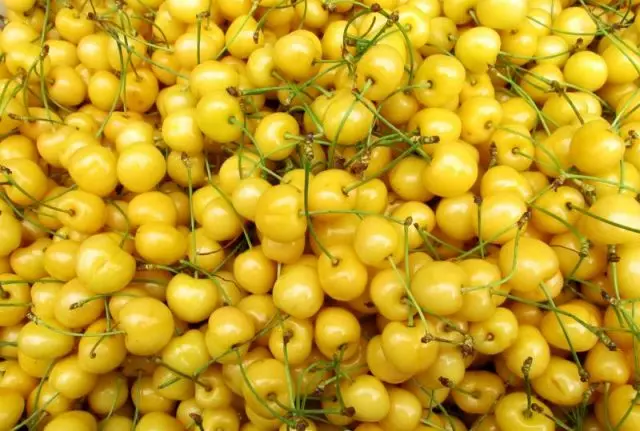
These include the following:
- Appetizing.
- Aelita.
- Bigarro yellow.
- Generalskaya.
- Summer resident.
- Drogana is yellow.
- Leningrad yellow.
- Homestead yellow.
- Rossosh gold.
- Franz Joseph.
- Chermashnaya.
- Amber.
Yellow cherry is tasty and healthy. It differs only in low keeping quality and transportability. With an excess amount of moisture in the soil, the fruits may crack.
red cherry
Red cherries include varieties of cherries, the fruits of which are colored red of varying intensity. This group is the largest.
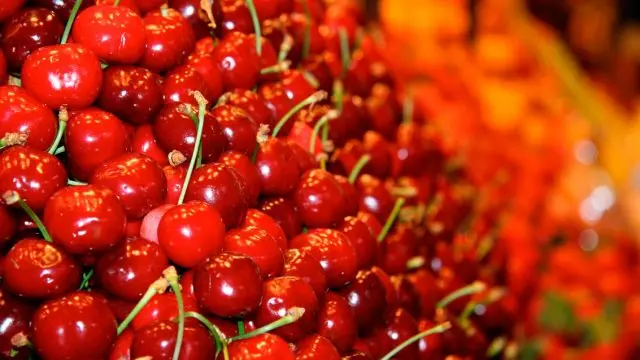
This includes the following representatives:
- Adelina.
- Spring.
- Bull heart.
- Valery Chkalov.
- Vasilisa.
- Knowledge.
- Iput.
- Italian.
- Large-fruited.
- Lena.
- People’s
- Ovstuzhenka.
- Farewell.
- Regina.
- Homeland.
- Tyutchevka.
pink cherry
Cherries with pink fruits are not as common as red cherries. Most varieties with this color of berries are dessert.
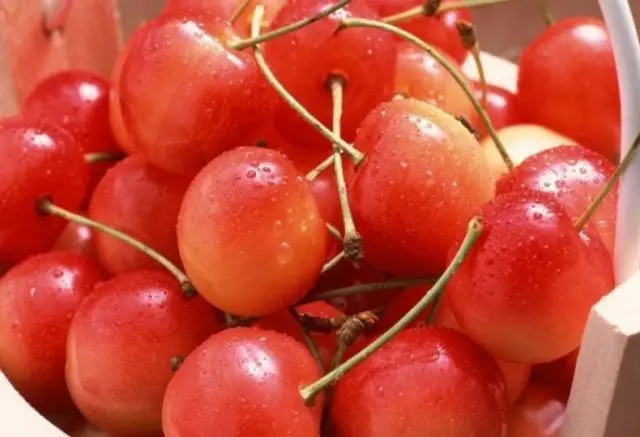
This includes types such as:
- Bryansk pink.
- Leningrad pink.
- Oryol.
- Early pink.
- Pink pearl.
- Fatej.
- Julia.
black cherry
Cherries with maroon, almost black fruits are classified as black. As a rule, it is best suited for transportation and storage.

Blacks include:
- Vasilisa.
- Diber black.
- Ilchishin.
- Kuban black.
- Leningrad black.
- Astakhov’s favorite.
- Melitopol.
- Mlievskaya.
- Revna.
- Regina.
- Rossoshanskaya.
- French black.
- Black Prince.
- Black sweetness.
Systematization of sweet cherry varieties by ripening time
In total, there are three main groups into which all varieties of sweet cherries are divided according to ripening time. These are early (end of May-beginning of June), mid-season (end of June-beginning of July) and late (end of July-beginning of August).
Early cherry: photo, varieties, description
Early ripe cherries already at the end of May are able to please the gardener with the taste of ripe berries. Here are the most common varieties of early ripening:
Valery Chkalov. Quite common, ripens in early June.
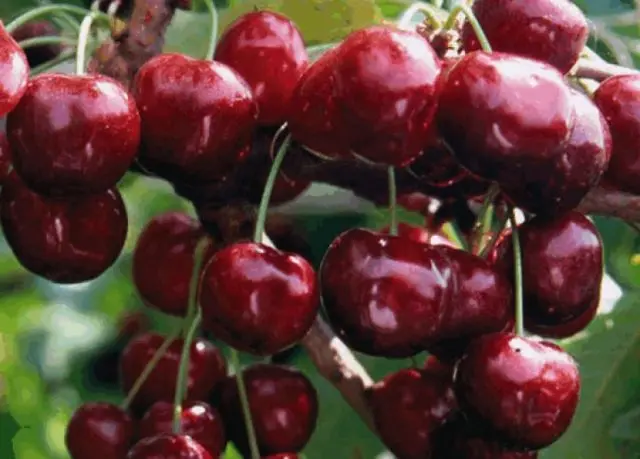
The berries are large, with an average weight of 7–9 g, burgundy. Productivity – 50-60 kg from one adult tree.
Melitopol early. Ripens early June.

Berries of average weight 6-7 g, dark red. The yield is about 50 kg per tree. Fruits of universal purpose, suitable for home canning and for fresh consumption.
Mayskaya. Ripens in late May-early June.
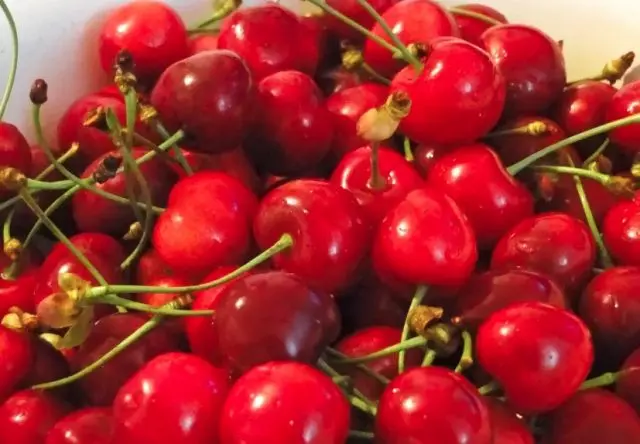
Exclusively dessert variety, suitable only for fresh consumption. The berries are bright red, small, 3-4 g in weight. Productivity from one tree – up to 40 kg.
Homestead. Very popular, ripening in early June.
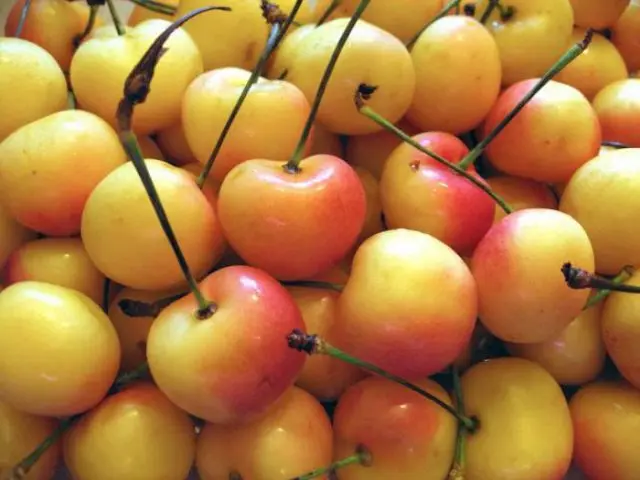
Berries are yellow with a bright blush. Their average weight is 5–6 g, the total yield is up to 85 kg. The fruits tolerate transportation well and can be used both for fresh consumption and for canning.
Sweet cherries of medium maturity
Mid-season varieties include varieties that have a ripening period from mid-June to mid-July. As a rule, all of them are universal in their purpose, have good taste indicators and have good transportability. Here are some of the representatives of this group.
Revna. The berries are dark red, ripening by mid-July.

The average fruit weight is 5–5,5 g. Resistant to cracking even in high humidity conditions. A very popular variety due to its high winter hardiness. The yield is high.
Fatej. No less popular, grown not only in the European part of Our Country, but also beyond the Urals.
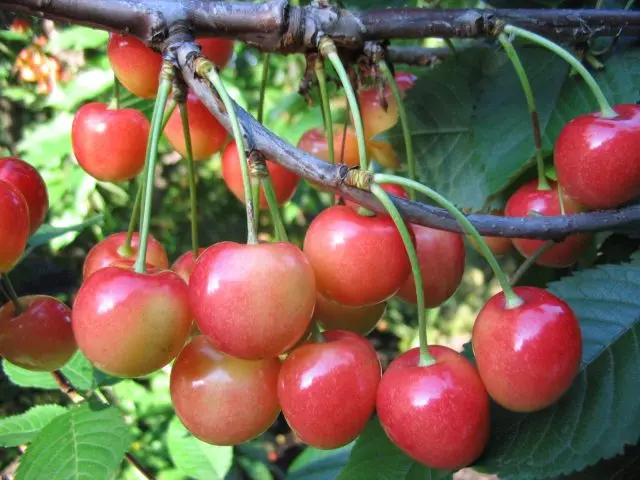
The berries are small, 4,5–6 g, pale yellow with a beautiful blush. The average yield is about 30 kg per tree, with good agricultural practices and in a favorable climate, it can be increased by 1,5–2 times. A versatile variety with good transportability.
Vasilisa. One of the largest varieties. The mass of berries can be from 11 g and above.
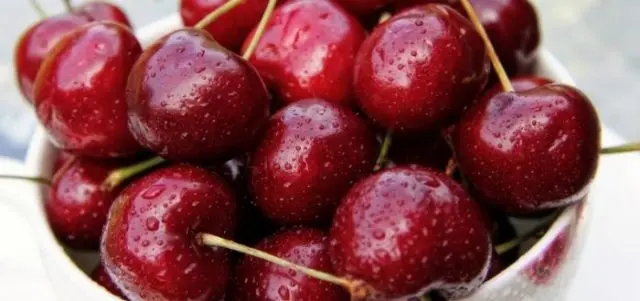
The yield is about 30 kg per tree, but with proper cultivation it can reach up to 50 kg or more. The variety is also good because the first berries on the tree may appear already in the second year after planting. Versatile, good for any use. Excellent appearance, combined with good taste and fruit resistance to transportation, makes it one of the most commercially attractive.
Surprise. It has good resistance to frost and perfectly tolerates heat and drought.
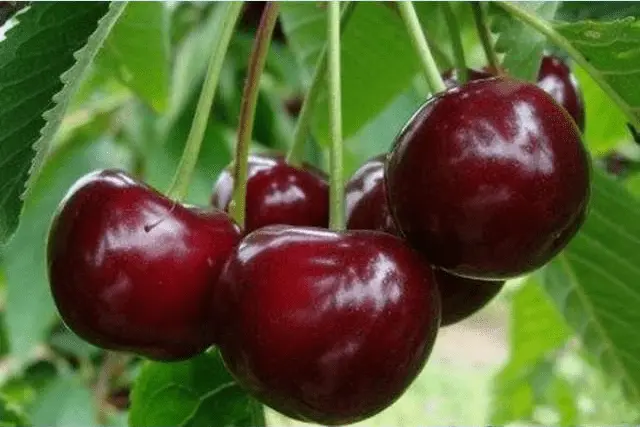
The berries are dark red, large, weighing up to 10 g. Productivity is high. Universal purpose.
Late cherry varieties
Late varieties usually have a good taste and aroma, and due to the thicker skin, increased resistance to transportation. Here is some of them.
Tyutchevka. Well known and loved by many. Ripens at the end of July.
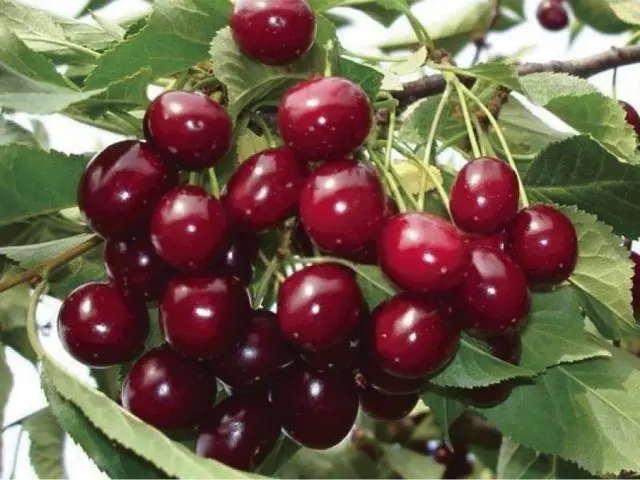
It has good performance in all respects, the only drawback of it can be considered the tendency of berries to crack in excessively wet weather. Berries of medium size and weight (about 7 g), high yield.
Regina. Quite fruitful and resistant to frost, heat and disease variety, the result of the work of German breeders. Ripens at the end of July, under adverse weather conditions and later.
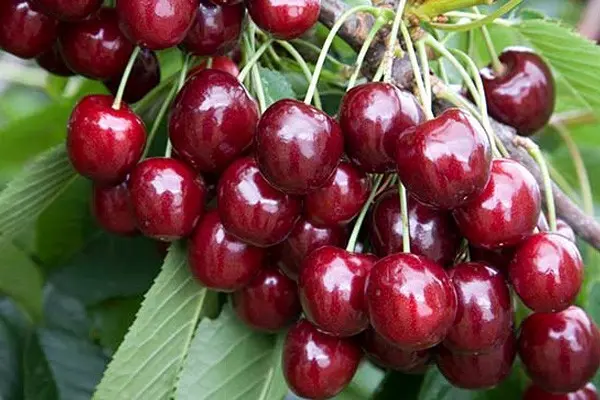
Fruits of dark crimson color, rather large 8,5-11 g, universal purpose. Productivity can reach 40 kg from one tree and above.
Bryansk pink. Ripens early August.

The berries are medium-sized, their average weight is 4,5–5,5 g. A versatile variety suitable for canning or fresh consumption. There is a noticeable bitterness in the taste of berries, which is negatively evaluated by many.
Self-fertile cherries
The term “self-fertility” is practically not applicable to most varieties of sweet cherries. This plant does not pollinate itself and requires the presence of a number of pollinating trees for normal fruiting. However, many still use this characteristic in the description.
What does “self-fertile cherries” mean?
A tree is considered self-fertile if it produces 15–40% of the total number of flowers. If the number of ovaries is less than 4%, the plant is considered self-infertile. Intermediate values allow the variety to be called partially self-fertile.
Numerous experiments conducted with various varieties of sweet cherries did not reveal self-fertility above 35%. The main mass has a much lower percentage (5–10), which allows us to speak of them only as partially self-fertile.
Self-pollinated cherry varieties
There are not so many varieties of sweet cherries that can produce crops without cross-pollination. Here is some of them:
- A blessing.
- Valery Chkalov.
- Goryanka.
- Danna.
- Pridonskaya.
- Homestead yellow.
Pollinator varieties for self-fertile cherries
Most sweet cherries require cross-pollination to set fruit. For this, any other blooming at the same time can be suitable. It is enough just to put them side by side.
What is a “self-infertile cherry variety”
Most sweet cherries are self-sterile, meaning they cannot pollinate themselves. Moreover, whole groups of varieties can be self-sterile. Therefore, to obtain a crop, a prerequisite is the presence of a pollinator.
How to choose the right pollinator
For a guaranteed harvest, it is recommended to plant at least three different varieties of sweet cherries that coincide in terms of flowering. Iput is most often used as a pollinator; it is a fairly universal species that coincides in flowering time with many others.
Classification of cherry varieties depending on the height of the tree
The cherry tree itself is quite tall. However, it is inconvenient to work with such a high crown, it is impossible to cut it, and the birds are guaranteed to get the upper tier of fruits. Therefore, more and more gardeners prefer low-growing trees, growing them on a dwarf rootstock or forming it in the form of a low bush.
dwarf cherry
An undoubted plus of dwarf trees is the ability to completely cover them for the winter, which can significantly increase winter hardiness. You can plant such trees both for harvest and for decorative purposes.
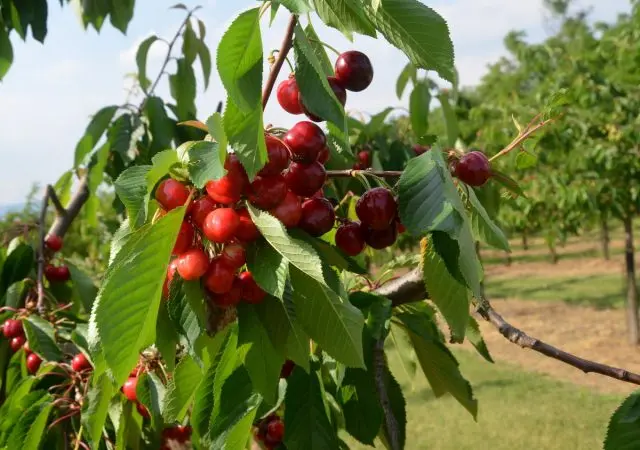
The most famous varieties of dwarf cherries are:
- Winter pomegranate.
- Saratov baby.
Low-growing varieties of cherries
Low-growing trees are 2,5–3 m high. These varieties include the following:
- Kid.
- Fatej.
- Original.
- Weeping.
Currently, breeders from different countries are conducting research in this area. With the help of radiation suppression of the tall stature gene, Canadian scientists obtained clones of the Compact Lambert and Compact Stella varieties with a low crown.
Medium-sized varieties of cherries
Most of the formed trees have a height of 3,5–5 meters. This is a standard height that allows you to work with the crown using various devices (ladders, stepladders, etc.). Medium varieties include:
- Tyutchevka.
- Iput.
- Leningrad black.
- Revna.
- Ovstuzhenka.
- Melitopol early.
- Italian.
Tall cherry varieties
Tall varieties can fully realize their fruit potential. However, working with such a high crown is rather inconvenient, processing and harvesting takes a lot of time. Tall trees are usually grown in the southern regions of the country, without limiting the growth of the bole in height and performing only sanitary pruning.

Tall varieties are as follows:
- Bigarro yellow.
- Generalskaya.
- Drogana is yellow.
- Krasnodar early.
- Large-fruited.
- Leningrad yellow.
- Leningrad pink.
- Homestead yellow.
- Franz Joseph.
- Amber.
Separation of sweet cherry varieties according to taste characteristics
Cherry fruits contain sugar and organic acids, depending on the concentration of which the taste of the berries will change from sweet and sour to sweet. Sweeter ones are used fresh, for the production of juices and in winemaking, berries with sourness are often preserved by adding one or another percentage of sugar.
Which cherry is the most delicious and sweet
There are no comrades for the taste and color, so the most delicious cherry probably does not exist. Among the varieties with the highest tasting score for taste, the following can be distinguished (table).
Grade | Tasting score (out of a possible 5 points) |
Brianochka | 5 |
Revna | 4,9 |
Tyutchevka | 4,9 |
Gronkova | 4,8 |
In memory of Chernyshevsky | 4,8 |
Poetry | 4,8 |
pink pearl | 4,8 |
Adeline | 4,7 |
Homestead yellow | 4,7 |
Pink sunset | 4,7 |
Teremoshka | 4,7 |
Red hill | 4,6 |
Ипуть | 4,5 |
Ovstuzhenka | 4,5 |
Radica | 4,5 |
Rechitsa | 4,5 |
Fitting | 4,5 |
The sweetest are Yaroslavna and Ovstuzhenka, having in their composition 14,2 and 13% of the sugar content, respectively.
large cherry
Undoubtedly, the large size of the fruit always pleases the gardener’s eye. Among the varieties of cherries, there are also champions. Such large-fruited include those that have a fruit weight of 7 g or more. Here is some of them:
- Annushka (9–10 g).
- Bull’s heart (7-10g).
- Vasilisa (11–14 years old).
- Friendship (10-11 years).
- Donetsk beauty (7–10 g).
- Italian (7-8 g).
- Folk (7–10 g).
Popular varieties of cherries
The popularity of a particular variety of sweet cherry is often dictated by the climatic conditions of the region, and not by the preferences or wishes of the gardener. Therefore, in the Central region and the Volga region, frost-resistant varieties are popular, such as Revna, Iput, Fatezh, Ovstuzhenka, Tyutchevka. The same varieties are preferred by gardeners in Siberia and the Urals.
In more southern areas, the choice is wider. This culture is grown there not only for personal consumption, but also for commercial purposes. Therefore, preference is given to large-fruited varieties with good resistance to transportation: Yaroslavna, Large-fruited, Annushka, Druzhba, Regina, etc.
Harvest cherry varieties
Do not forget that the yield of a tree largely depends not on the variety, but on the growing conditions: climate, soil composition, regularity of fertilizing, watering. Affects yield and pruning method. With good care, the number of berries collected from a tree can exceed the average by several times. Among the varieties that consistently produce high yields, the following can be noted:
- Farewell.
- Yaroslavna
- Tyutchevka.
- Cordia.
- Diber black.
- Dzherelo.
- Franz Joseph.
- Donetsk beauty.
Imported cherry varieties
The rapidly developing Internet commerce has led to the fact that more and more varieties of foreign selection began to appear in Our Country. These include the already mentioned German Drogana Zheltaya, Regina, Czech Kordia. Many varieties of sweet cherries are imported from the USA and Canada. These are varieties such as:
- PC 7217-8.
- Sunburst.
- Kootenay.
- Skeena.
- Sweethtart.
- Staccato and others.
New varieties of cherries
Breeding work does not stand still, and new specimens appear quite regularly. Recently emerging promising varieties include the following:
- Madonna.
- Caucasian improved.
- Kuban morning.
- Sasha.
- South.
- Ruby Kuban.
- Black eyes.
- Velvet.
- Enchantress.
- Contrasting.
- Announcement.
- Poppy.
- Scarlet.
All these varieties are the result of the work of domestic breeders, and it is possible that in the near future many of them will take their place in the gardens of our country.
Unpretentious varieties of cherries
Cherry needs care and the “plant and forget” option will not work with it. However, there are some varieties that, even with minimal care, are able to show a good stable yield. These include:
- Revna.
- Ovstuzhenka.
- People’s Syubarova.
Leave trees completely unattended. This will lead to a rapid thickening of the crown, the development of diseases, and the chopping of berries.
What kind of cherry to choose
When choosing sweet cherries for planting, you should, first of all, pay attention to zoned varieties that are most suitable for the growing region. If there are none, you should choose the most suitable for the climate. Personal experience or the advice of experienced gardeners can play an important role.
Conclusion
Many varieties of cherries are able to produce a good stable crop. Among them are both new and well-known and loved by gardeners. With the modern wealth of choice, everyone will be able to find the most suitable variety in all respects, you just need not be afraid of the amount of work and meet the required deadlines.









